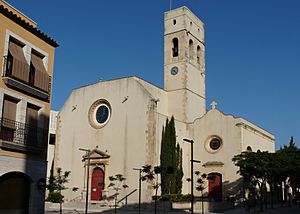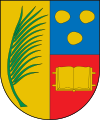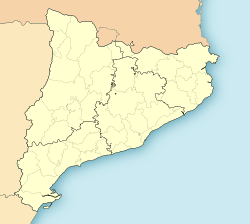Vila-seca facts for kids
Quick facts for kids
Vila-seca
|
||
|---|---|---|
|
Municipality
|
||

Sant Esteve church
|
||
|
||
| Country | Spain | |
| Community | Catalonia | |
| Province | Tarragona | |
| Comarca | Tarragonès | |
| Government | ||
| • Type | Mayor–council | |
| • Body | Ajuntament de Vila-seca | |
| Area | ||
| • Total | 21.6 km2 (8.3 sq mi) | |
| Elevation
(AMSL)
|
42 m (138 ft) | |
| Population
(2018)
|
||
| • Total | 22,107 | |
| • Density | 1,023.5/km2 (2,651/sq mi) | |
| Demonym(s) | vila-secà, vila-secana vila-secano, vila-secana |
|
| Postal code |
43480
|
|
| Area code | +34 (Spain) 977 (Province) | |
Vila-seca (pronounced VEE-lah-SEH-kah) is a town in Catalonia, Spain. Its name means 'Dry-town'. It is part of the Tarragonès area in the Tarragona province. Vila-seca is a municipality, which is like a local government area.
The town includes the areas of La Plana and La Pineda. Vila-seca is also home to a very large industrial area with many factories that make chemicals. This area is shared with nearby cities like Tarragona. It is one of the biggest chemical production areas in Europe.
Contents
A Look at Vila-seca's Past
Early Settlements and Roman Times
People have lived in the area of Vila-seca for a very long time. We know this because old objects and buildings from the time of Ancient Rome have been found here. These discoveries show that the town has a rich history.
How Vila-seca Became One Town
In 1162, a king named Alfonso II of Aragon gave these lands to a family called Olzina. Later, in 1208, King Peter II of Aragon confirmed this gift.
During the Middle Ages, there were actually two towns. One was Vila-seca, owned by the Olzina family. The other was called Vilaseca del Comú. This second town belonged to the Archbishop of Tarragona. In 1525, the two towns officially joined together. This is how the single town of Vila-seca, as we know it today, was formed.
Defending the Port and Facing Pirates
Vila-seca played an important role in protecting the port of Salou. This port was a key place for trade and defense. It brought a lot of money to the area. For a long time, it was the main port for many nearby communities.
However, King Ferdinand II of Aragon later stopped its use. Vila-seca then became the main port. This made the town a target for pirate attacks from North Africa. To keep the town safe, people built special watchtowers and defense towers. These towers helped to spot and protect against the pirates.
Wars and Challenges
Vila-seca faced tough times during different wars. During the Reapers' War, soldiers from King Philip IV of Spain took over the town. Many people who defended the town were harmed, and the church and town hall were burned down. The town also suffered greatly during the Peninsular War.
In 1989, the area of Salou became its own separate municipality. Before that, it was part of Vila-seca.
Fun Things to Do in Vila-seca
Popular Tourist Spots
In recent years, Vila-seca has become a popular place for tourists. The area of La Pineda has been improved with new hotels and a nicer beach. There are also many fun attractions for visitors.
You can visit aquopolis, a water park with exciting slides and pools. It also has shows with amazing dolphins and sea lions. For older kids and teens, there's also Pacha, a well-known place for music and nightlife.
Getting There by Air
The area is easy to reach by plane. Reus Airport is nearby and has many flights from different parts of Europe and North Africa. Barcelona Airport is also an option for travelers coming to the region.
Shopping and Food
Vila-seca has many different shops and restaurants. Most of them are local, independent businesses. You can find a Lidl supermarket that was built around 2007. There is also a McDonald's on the main road called Raval de la Mar, which leads into the town.
Images for kids
See also
 In Spanish: Vilaseca para niños
In Spanish: Vilaseca para niños





